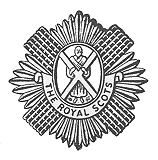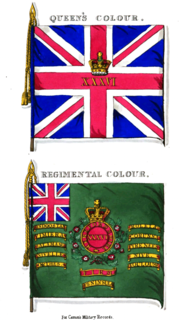Related Research Articles

The Infantry of the British Army, part of the structure of the British Army, comprises 49 infantry battalions, from 19 regiments. Of these, 33 battalions are part of the Regular army and the remaining 16 a part of the Army Reserve. The British Army's Infantry forms a highly flexible organisation, taking on a variety of roles, including armoured, mechanised, air assault and light.

The Royal Scots , once known as the Royal Regiment of Foot, was the oldest and most senior infantry regiment of the line of the British Army, having been raised in 1633 during the reign of Charles I of Scotland. The regiment existed continuously until 2006, when it amalgamated with the King's Own Scottish Borderers to become the Royal Scots Borderers, which merged with the Royal Highland Fusiliers, the Black Watch, the Highlanders and the Argyll and Sutherland Highlanders to form the Royal Regiment of Scotland.
The 96th Regiment of Foot was a British Army regiment, raised in 1798. Under the Childers reforms it amalgamated with the 63rd Regiment of Foot to form the Manchester Regiment.

The 73rd Regiment of Foot was an infantry regiment of the British Army, raised in 1780. Under the Childers Reforms it amalgamated with the 42nd Regiment of Foot to form the Black Watch in 1881.
The 135th (Limerick) Regiment of Foot was an infantry regiment of Fencibles in the British Army, created and promptly disbanded in 1796. The regiment, raised by Sir Vere Hunt, did not see any active service; it served solely to recruit soldiers. On disbandment, the recruits were drafted into other regiments. The regiment has the interesting historical distinction of having had the highest regimental number of any British line regiment.
The 134th Regiment of Foot was an infantry regiment of the British Army, created in 1794 and disbanded in 1796. The regiment was formed in Ireland by redesignating the newly raised 2nd Battalion of the 83rd Regiment of Foot, and did not leave Ireland before being disbanded in 1796.
The 132nd (Highland) Regiment of Foot was a Scottish infantry regiment of the British Army, created in 1794 and disbanded in 1796. The regiment was raised by Duncan Cameron of Cullart, and did not see any active service; it served solely to recruit soldiers. On disbandment, the recruits were drafted into the Black Watch.

The 36th (Herefordshire) Regiment of Foot was an infantry regiment of the British Army, raised in 1701. Under the Childers Reforms it amalgamated with the 29th (Worcestershire) Regiment of Foot to form the Worcestershire Regiment in 1881. Its lineage is continued today by the Mercian Regiment.
The 123rd Regiment of Foot was an infantry regiment of the British Army, formed in 1762 and disbanded in 1764. Its colonel was John Pomeroy.
The 123rd Regiment of Foot was an infantry regiment of the British Army, formed in 1794 and disbanded in 1796; it took its title from the 100th Foot, disbanded in 1785.
The 100th Regiment of Foot, also known as Campbell's Highlanders, was an infantry regiment of the British Army, formed in 1760 and disbanded in 1763.
The 87th Regiment of Foot was a Scottish infantry regiment in the British Army, formed in 1759 and disbanded in 1763.
The 73rd Regiment of Foot (Invalids) was an infantry regiment of the British Army from 1762 to 1768.
The 115th Regiment of Foot was an infantry regiment of the British Army from 1761 to 1763.
The 114th Regiment of Foot was an infantry regiment of the British Army from 1761 to 1763.It was raised in October 1761, by Sir Allan MacLean of Torloisk. He was commissioned lieutenant in the 60th Foot Royal Americans at the beginning of the Seven Years' War and was severely wounded at Ticonderoga in 1758. He was then given one of the four NY Independent Companies until he returned to Scotland where he raised the 114th Maclean's Highlanders, or the Royal Highland Volunteers, as their Major Commandant. The regiment was disbanded in 1763.
The 108th Regiment of Foot was an infantry regiment of the British Army. However, it was raised initially as part of the Madras Army, by the East India Company (EIC) in 1766.
The 109th (Aberdeenshire) Regiment of Foot was an infantry regiment of the British Army from 1794 to 1795. Raised by Alexander Leith Hay for service in the French Revolutionary Wars the regiment was briefly deployed in Jersey before it was disbanded in England and its men sent to reinforce the 53rd (Shropshire) Regiment of Foot. The disbandment was controversial as Leith-Hay believed it contravened an assurance given to him in his original letter of service to raise the regiment.
The 103rd Regiment of Foot was formed as the 9th Garrison Battalion in November 1806. It became the 103rd Regiment of Foot in 1808. In 1809 the 9th garrison battalion, was transferred to the 103rd Regiment.
The 73rd Regiment of Foot was a regiment in the British Army from 1758 to 1763. It was formed on 28 April 1758 from the 2nd Battalion of the 34th Regiment of Foot, and served in Ireland until it was disbanded in 1763.
References
- ↑ "133rd Regiment of Foot". regiments.org. Archived from the original on 16 October 2007.